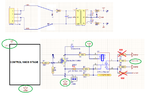Follow along with the video below to see how to install our site as a web app on your home screen.
Note: This feature may not be available in some browsers.
Relays are already isolated. Why another isolated power supply?I just want to supply three relays
* the green part basically is just a diode. How/why do you want to isolate the diode. What will be the function of an isolated diode?I would like to isolate the Green part from the Black part of the image.
I see only one Relay.I just want to supply three relays.

You may join them if you like. It won´t hurt.because at the output stage I am joining isolated GND from the DCDC converter with the reference GND of +24V.




I think you are saying that your +/-15V is floating and so should not share the same ground (in your circuit) with your 24V.
If so, I would suggest you drive the relay coil with your 15V and then connect the contact side of the relay to 24V. The LED end and the jumper end should be connected to the 24V GND. The MOSFET source terminal should be connected to the 15V GND.
I hope that is what you asked about.
You also may operate a relay with a rated coil-voltage of 12 V with 15 V e.g. for [1] the maximum coil-voltage is 170 % the rated voltage.
Thus your maximum voltage for the 12 V version would be 12 V • 1.7 = 20.4 V.
[1] https://omronfs.omron.com/en_US/ecb/products/pdf/en-g5le.pdf
greets
